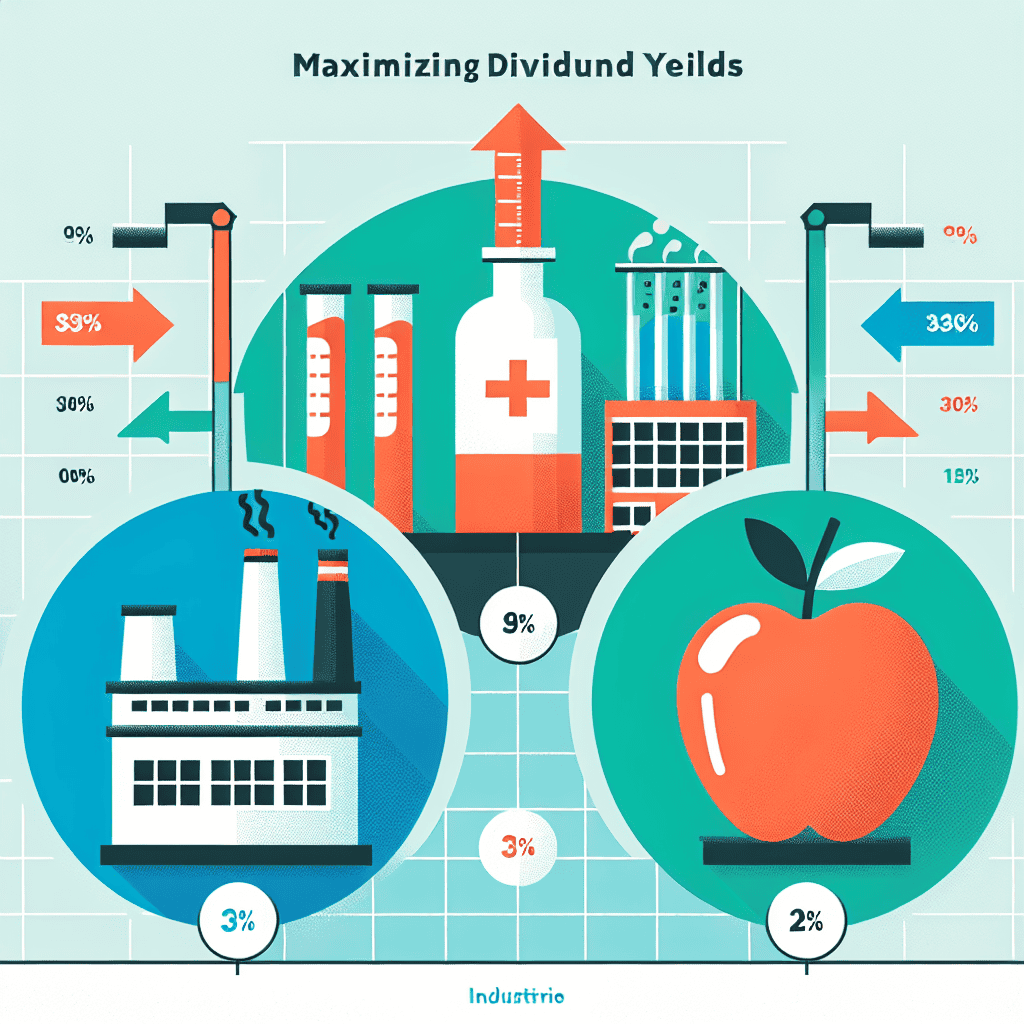“Unlock Wealth: Discover the Top 3 Sectors for Maximizing Dividend Yields!”
Introduction
Investors seeking to maximize dividend yields often turn to specific sectors known for their consistent and robust dividend payouts. Among these, the utilities, consumer staples, and real estate sectors stand out as top contenders. The utilities sector, encompassing companies that provide essential services such as electricity, water, and natural gas, is renowned for its stable cash flows and regulatory support, which often translate into reliable dividend payments. Consumer staples, which include companies producing essential goods like food, beverages, and household products, offer resilience in various economic climates, ensuring steady dividends. Lastly, the real estate sector, particularly Real Estate Investment Trusts (REITs), is structured to distribute a significant portion of income as dividends, making it an attractive choice for yield-focused investors. These sectors collectively provide a strategic avenue for those aiming to enhance their income through dividends.
Understanding Dividend Yields: A Primer for Investors
Dividend yields represent a crucial metric for investors seeking to maximize their returns through income-generating assets. Understanding dividend yields involves grasping the relationship between a company’s annual dividend payments and its stock price. This ratio, expressed as a percentage, provides insight into the income an investor can expect relative to the price of the stock. As investors navigate the complex landscape of dividend investing, identifying sectors that consistently offer high dividend yields can be a strategic approach to enhancing portfolio performance. Among the myriad of sectors available, three stand out for their potential to maximize dividend yields: utilities, real estate investment trusts (REITs), and consumer staples.
To begin with, the utilities sector is renowned for its stable and attractive dividend yields. Companies within this sector, such as those providing electricity, water, and natural gas, operate in a highly regulated environment. This regulatory framework ensures a steady demand for their services, which translates into predictable revenue streams. Consequently, utility companies are often able to distribute a significant portion of their earnings as dividends. Moreover, the essential nature of utility services means that these companies are less susceptible to economic downturns, providing a level of security for dividend-seeking investors. As a result, the utilities sector remains a popular choice for those looking to achieve consistent income through dividends.
Transitioning to another promising sector, real estate investment trusts (REITs) offer a unique opportunity for investors to tap into high dividend yields. REITs are companies that own, operate, or finance income-producing real estate across various property sectors. By law, REITs are required to distribute at least 90% of their taxable income to shareholders in the form of dividends. This requirement often results in higher dividend yields compared to other sectors. Additionally, the diverse range of properties within REIT portfolios, from commercial spaces to residential units, provides investors with exposure to different market dynamics. This diversification can help mitigate risks and enhance the potential for stable dividend income. Furthermore, as the real estate market continues to evolve, REITs offer investors the chance to benefit from both capital appreciation and income generation.
Finally, the consumer staples sector is another area where investors can find attractive dividend yields. Companies in this sector produce essential goods such as food, beverages, and household products, which remain in demand regardless of economic conditions. This consistent demand allows consumer staples companies to generate reliable cash flows, enabling them to pay regular dividends to shareholders. Moreover, many companies in this sector have established strong brand loyalty and extensive distribution networks, further solidifying their market position. As a result, consumer staples companies often exhibit resilience during economic downturns, making them a dependable choice for dividend-focused investors.
In conclusion, understanding dividend yields is essential for investors aiming to maximize their returns through income-generating assets. By focusing on sectors such as utilities, real estate investment trusts, and consumer staples, investors can identify opportunities to achieve higher dividend yields. Each of these sectors offers unique advantages, from the stability of utility companies to the legal requirements governing REITs and the consistent demand for consumer staples. As investors seek to build a robust portfolio, considering these sectors can provide a strategic pathway to achieving their income objectives.
Top 3 Sectors for Maximizing Dividend Yields in 2023
In 2023, investors seeking to maximize dividend yields are increasingly turning their attention to specific sectors that have demonstrated resilience and consistent performance. As the global economy continues to navigate post-pandemic recovery, inflationary pressures, and geopolitical uncertainties, identifying sectors that offer robust dividend yields has become a strategic priority for income-focused investors. Among the myriad of options available, three sectors stand out for their potential to deliver attractive dividend returns: utilities, real estate investment trusts (REITs), and consumer staples.
Firstly, the utilities sector remains a cornerstone for dividend-seeking investors due to its inherent stability and reliable cash flow generation. Utilities companies, which provide essential services such as electricity, water, and natural gas, benefit from steady demand regardless of economic cycles. This consistent demand allows them to maintain and often increase their dividend payouts over time. In 2023, the utilities sector is particularly appealing as it continues to invest in renewable energy and infrastructure upgrades, which not only enhance long-term growth prospects but also align with global sustainability trends. Furthermore, the regulatory environment in many regions supports predictable revenue streams, making utilities a dependable choice for those prioritizing dividend income.
Transitioning to the real estate investment trusts (REITs) sector, investors find another compelling opportunity for maximizing dividend yields. REITs are known for their ability to generate substantial income through rental properties, and they are required by law to distribute a significant portion of their earnings as dividends. This structural advantage makes REITs an attractive option for income-focused portfolios. In 2023, the REITs sector is poised to benefit from a recovering real estate market, with segments such as industrial, residential, and healthcare properties showing particular promise. The ongoing demand for logistics and warehousing space, driven by the e-commerce boom, further bolsters the industrial REITs segment. Meanwhile, demographic trends and an aging population continue to support the growth of healthcare REITs. As a result, investors can expect REITs to offer competitive dividend yields, underpinned by strong occupancy rates and rental income.
Lastly, the consumer staples sector emerges as a reliable source of dividend income, especially in times of economic uncertainty. Companies within this sector produce essential goods such as food, beverages, and household products, which remain in demand regardless of economic conditions. This consistent demand translates into stable revenue streams and, consequently, dependable dividend payouts. In 2023, consumer staples companies are navigating challenges such as rising input costs and supply chain disruptions; however, their ability to pass on costs to consumers and maintain profit margins underscores their resilience. Additionally, many consumer staples companies boast strong balance sheets and a history of dividend growth, making them a favored choice for conservative investors seeking steady income.
In conclusion, the utilities, REITs, and consumer staples sectors each offer unique advantages for investors aiming to maximize dividend yields in 2023. By focusing on these sectors, investors can benefit from the stability and growth potential inherent in essential services, real estate, and consumer goods. As the global economic landscape continues to evolve, these sectors provide a solid foundation for building a dividend-focused investment strategy, ensuring that investors can achieve their income objectives while navigating the complexities of the financial markets.
Why Utilities Remain a Strong Sector for Dividend Investors
In the realm of dividend investing, the utilities sector has long been a stalwart, offering investors a reliable source of income through consistent dividend payouts. This sector, encompassing companies that provide essential services such as electricity, water, and natural gas, is often characterized by its stability and resilience, even in times of economic uncertainty. As investors seek to maximize dividend yields, understanding why utilities remain a strong sector for dividend investors is crucial.
One of the primary reasons utilities are favored by dividend investors is their inherent stability. Utilities operate in a regulated environment, which provides a predictable revenue stream. This regulatory framework ensures that utility companies can pass on costs to consumers, thereby maintaining steady cash flows. Consequently, these companies are able to offer attractive dividend yields, often higher than those found in other sectors. Moreover, the essential nature of the services provided by utilities means that demand remains relatively inelastic, even during economic downturns. This consistent demand further bolsters the sector’s ability to generate reliable income for investors.
In addition to stability, the utilities sector benefits from a relatively low level of competition. The high barriers to entry, including significant capital requirements and regulatory hurdles, limit the number of new entrants. This lack of competition allows existing utility companies to maintain their market positions and continue generating steady profits. As a result, these companies can focus on returning capital to shareholders in the form of dividends. Furthermore, the long-term contracts and fixed-rate agreements that are common in the utilities sector provide additional revenue certainty, enabling companies to plan and sustain dividend payments over time.
Another factor contributing to the attractiveness of utilities for dividend investors is the sector’s potential for growth. While traditionally viewed as a mature industry, the utilities sector is undergoing a transformation driven by the global push towards renewable energy and sustainability. This shift presents opportunities for utility companies to invest in new technologies and infrastructure, potentially leading to increased revenues and, subsequently, higher dividends. As governments and consumers alike prioritize clean energy, utility companies that successfully adapt to these changes may experience growth, further enhancing their appeal to dividend-focused investors.
Moreover, the utilities sector’s strong track record of dividend payments is a testament to its reliability. Many utility companies have a history of not only maintaining but also increasing their dividends over time. This commitment to returning value to shareholders is a key consideration for dividend investors seeking both income and growth. The ability of utility companies to consistently deliver dividends, even during challenging economic periods, underscores their role as a cornerstone of a diversified dividend portfolio.
In conclusion, the utilities sector remains a compelling choice for dividend investors due to its stability, low competition, growth potential, and strong dividend track record. As the global economy continues to evolve, the essential nature of utility services ensures that demand will persist, providing a solid foundation for dividend payments. For investors seeking to maximize dividend yields, the utilities sector offers a combination of reliability and opportunity, making it an enduring pillar of dividend investment strategies. By understanding the unique attributes of this sector, investors can make informed decisions that align with their income and growth objectives.
Exploring the Financial Sector: A Dividend Yield Powerhouse

The financial sector has long been recognized as a cornerstone for investors seeking to maximize dividend yields. This sector, encompassing a wide range of institutions such as banks, insurance companies, and real estate investment trusts (REITs), offers a robust platform for generating consistent income. As we delve into the intricacies of this sector, it becomes evident why it stands out as a dividend yield powerhouse.
To begin with, banks are a fundamental component of the financial sector, playing a pivotal role in the economy by facilitating capital flow and providing essential financial services. Their ability to generate substantial profits through interest income and fees allows them to distribute a significant portion of earnings to shareholders in the form of dividends. Moreover, banks often maintain a stable dividend payout ratio, which is appealing to income-focused investors. This stability is further reinforced by regulatory frameworks that ensure banks maintain adequate capital reserves, thereby safeguarding their ability to continue paying dividends even during economic downturns.
Transitioning to insurance companies, these entities also contribute significantly to the financial sector’s reputation for high dividend yields. Insurance firms generate revenue through premiums and investment income, which provides a steady cash flow. This financial stability enables them to offer attractive dividends to shareholders. Additionally, the insurance industry benefits from relatively predictable cash flows and risk management strategies, which further enhance their capacity to maintain consistent dividend payments. As a result, investors often view insurance companies as reliable sources of income, particularly in times of market volatility.
Furthermore, real estate investment trusts (REITs) are another critical segment within the financial sector that excels in delivering high dividend yields. By law, REITs are required to distribute at least 90% of their taxable income to shareholders in the form of dividends, making them inherently attractive to income-seeking investors. The underlying assets of REITs, primarily real estate properties, generate rental income, which provides a stable revenue stream. This stability, coupled with the tax advantages associated with REITs, makes them a compelling choice for those looking to maximize dividend yields. Additionally, the diverse range of REITs, from residential and commercial properties to specialized sectors like healthcare and data centers, offers investors the opportunity to tailor their portfolios according to their risk tolerance and income objectives.
In conclusion, the financial sector’s ability to deliver high dividend yields is underpinned by the stability and profitability of its key components: banks, insurance companies, and REITs. Each of these segments offers unique advantages that contribute to the sector’s overall appeal to income-focused investors. Banks provide consistent dividends backed by regulatory safeguards, insurance companies offer predictable cash flows and risk management, and REITs deliver high yields through mandated income distribution. As investors continue to seek reliable sources of income in an ever-changing economic landscape, the financial sector remains a formidable option for maximizing dividend yields. By understanding the dynamics and strengths of this sector, investors can make informed decisions that align with their financial goals and risk appetite.
Real Estate Investment Trusts: A Reliable Source of High Dividends
Real Estate Investment Trusts (REITs) have long been recognized as a reliable source of high dividends, making them an attractive option for income-focused investors. As entities that own, operate, or finance income-generating real estate, REITs are required by law to distribute at least 90% of their taxable income to shareholders in the form of dividends. This unique structure not only provides investors with a steady income stream but also offers the potential for capital appreciation. In the current economic climate, where interest rates remain relatively low, the appeal of REITs is further amplified as they often yield higher returns compared to traditional fixed-income investments.
One of the primary reasons REITs are able to offer such attractive dividends is their exposure to various real estate sectors, each with its own set of dynamics and growth drivers. For instance, the residential sector, which includes apartment complexes and single-family rental homes, benefits from consistent demand driven by population growth and urbanization trends. As more individuals and families seek rental properties, REITs in this sector can capitalize on rising rental rates and occupancy levels, thereby enhancing their dividend-paying capacity.
Moreover, the commercial real estate sector, encompassing office spaces, retail centers, and industrial properties, presents another lucrative avenue for REIT investors. Despite the challenges posed by the shift towards remote work and e-commerce, certain segments within this sector continue to thrive. Industrial REITs, for example, have experienced significant growth due to the surge in online shopping, which has increased the demand for warehouse and distribution facilities. This trend is expected to persist, providing a stable income stream for investors.
In addition to residential and commercial properties, specialized REITs focusing on niche markets such as healthcare facilities, data centers, and infrastructure also offer compelling dividend opportunities. Healthcare REITs, which invest in properties like hospitals, nursing facilities, and medical offices, benefit from the aging population and the increasing need for healthcare services. Similarly, data center REITs are poised for growth as the digital economy expands, necessitating more data storage and processing capabilities. These specialized REITs not only diversify an investor’s portfolio but also provide exposure to sectors with strong growth potential.
Furthermore, the tax advantages associated with REITs enhance their appeal as a dividend investment. Since REITs are not taxed at the corporate level, they can pass on more of their earnings to shareholders, resulting in higher dividend yields. This tax-efficient structure, combined with the potential for inflation protection through real estate ownership, makes REITs a compelling choice for those seeking to maximize their income.
However, it is important for investors to conduct thorough due diligence before investing in REITs. Factors such as the quality of the underlying properties, the management team’s expertise, and the REIT’s financial health should be carefully evaluated. Additionally, investors should be mindful of interest rate fluctuations, as rising rates can impact the cost of borrowing for REITs and potentially affect their dividend payouts.
In conclusion, Real Estate Investment Trusts offer a reliable and attractive source of high dividends, making them a valuable component of an income-focused investment strategy. By providing exposure to diverse real estate sectors and benefiting from favorable tax treatment, REITs can help investors achieve their income goals while also offering the potential for long-term capital appreciation. As with any investment, careful analysis and consideration of individual risk tolerance are essential to maximizing the benefits of investing in REITs.
Comparing Dividend Yields Across Sectors: Key Insights
In the ever-evolving landscape of investment opportunities, dividend yields remain a crucial consideration for investors seeking steady income streams. As market dynamics shift, understanding which sectors offer the most promising dividend yields can significantly enhance an investor’s portfolio strategy. By comparing dividend yields across various sectors, we can identify key insights that guide investment decisions. Among the myriad of sectors, three stand out for their potential to maximize dividend yields: utilities, consumer staples, and real estate investment trusts (REITs).
To begin with, the utilities sector has long been a stalwart for dividend-seeking investors. Characterized by stable cash flows and essential services, utility companies often provide reliable dividend payouts. The sector’s inherent stability stems from the consistent demand for electricity, water, and gas, which remains largely unaffected by economic cycles. This predictability allows utility companies to maintain and even increase their dividend distributions over time. Furthermore, regulatory frameworks often support these companies in passing on costs to consumers, ensuring a steady revenue stream. Consequently, investors looking for dependable income may find the utilities sector particularly appealing.
Transitioning to the consumer staples sector, we observe another area ripe for dividend yield maximization. Companies within this sector produce essential goods such as food, beverages, and household products, which enjoy consistent demand regardless of economic conditions. This resilience translates into stable earnings, enabling these companies to offer attractive dividend yields. Moreover, many consumer staples companies boast a long history of dividend payments, often with a track record of annual increases. This commitment to returning capital to shareholders makes the sector a reliable choice for income-focused investors. Additionally, the global nature of many consumer staples companies provides a diversified revenue base, further enhancing their ability to sustain dividends.
Moving on to real estate investment trusts (REITs), we find a sector uniquely structured to deliver high dividend yields. By law, REITs must distribute at least 90% of their taxable income to shareholders in the form of dividends, making them inherently attractive to income investors. The sector encompasses a wide range of property types, including residential, commercial, and industrial real estate, each offering distinct opportunities and risks. Despite potential market fluctuations, the tangible nature of real estate assets provides a level of security and income stability. Furthermore, as interest rates fluctuate, REITs can adjust their portfolios to capitalize on changing market conditions, potentially enhancing their dividend yields. This adaptability, combined with the mandatory distribution requirement, positions REITs as a compelling option for those seeking high dividend returns.
In conclusion, while each sector presents its own set of opportunities and challenges, utilities, consumer staples, and REITs consistently emerge as top contenders for maximizing dividend yields. The stability and essential nature of utilities, the resilience and global reach of consumer staples, and the structural advantages of REITs collectively offer investors a diverse array of options for generating income. As investors navigate the complexities of the financial markets, a keen understanding of these sectors’ dynamics can provide valuable insights into crafting a robust, income-generating portfolio. By strategically allocating investments across these sectors, investors can potentially enhance their dividend yields while mitigating risks, ultimately achieving a balanced and rewarding investment strategy.
Strategies for Investing in High-Dividend Sectors
Investing in high-dividend sectors can be a strategic approach for those seeking to maximize their income from stock investments. As investors navigate the complexities of the financial markets, identifying sectors that consistently offer attractive dividend yields becomes crucial. Among the myriad of options available, three sectors stand out for their potential to deliver robust dividend returns: utilities, real estate investment trusts (REITs), and consumer staples. Each of these sectors presents unique characteristics and opportunities that can enhance an investor’s portfolio.
To begin with, the utilities sector is often regarded as a cornerstone for dividend-focused investors. This sector includes companies that provide essential services such as electricity, water, and natural gas. Due to the indispensable nature of these services, utility companies tend to have stable and predictable cash flows. This financial stability allows them to distribute a significant portion of their earnings as dividends to shareholders. Moreover, the regulatory environment in which utilities operate often ensures a steady demand for their services, further reinforcing their ability to maintain consistent dividend payouts. As a result, investors looking for reliable income streams frequently turn to the utilities sector as a foundational component of their dividend strategy.
Transitioning to another promising sector, real estate investment trusts (REITs) offer a compelling avenue for dividend-seeking investors. REITs are companies that own, operate, or finance income-generating real estate across various property sectors, including residential, commercial, and industrial. By law, REITs are required to distribute at least 90% of their taxable income to shareholders in the form of dividends, making them inherently attractive for those focused on dividend yields. The diverse nature of real estate assets within REITs provides investors with exposure to different market segments, which can help mitigate risks associated with economic fluctuations. Furthermore, as the demand for real estate continues to grow, particularly in urban areas, REITs are well-positioned to capitalize on this trend, potentially enhancing their dividend-paying capacity.
In addition to utilities and REITs, the consumer staples sector is another area where investors can find high-dividend opportunities. This sector encompasses companies that produce essential goods such as food, beverages, and household products. The non-cyclical nature of consumer staples means that demand for these products remains relatively stable regardless of economic conditions. Consequently, companies within this sector often generate consistent revenue streams, enabling them to offer attractive dividends to shareholders. Moreover, many consumer staples companies have established strong brand loyalty and extensive distribution networks, which further bolster their financial resilience. For investors seeking a balance between income and stability, the consumer staples sector presents a viable option.
In conclusion, while each of these sectors—utilities, REITs, and consumer staples—offers distinct advantages, they all share a common trait: the potential to provide substantial dividend yields. By incorporating these sectors into their investment strategies, investors can enhance their portfolios with reliable income sources. However, it is essential for investors to conduct thorough research and consider their individual risk tolerance and investment goals before making any decisions. As the financial landscape continues to evolve, staying informed and adaptable will be key to successfully navigating the world of high-dividend investing.
Q&A
1. **Question:** What are the top three sectors known for maximizing dividend yields?
**Answer:** The top three sectors known for maximizing dividend yields are Utilities, Real Estate Investment Trusts (REITs), and Consumer Staples.
2. **Question:** Why is the Utilities sector considered good for dividend yields?
**Answer:** The Utilities sector is considered good for dividend yields because it consists of companies that provide essential services, leading to stable cash flows and the ability to pay consistent dividends.
3. **Question:** How do Real Estate Investment Trusts (REITs) maximize dividend yields?
**Answer:** REITs maximize dividend yields by being required to distribute at least 90% of their taxable income to shareholders, resulting in high dividend payouts.
4. **Question:** What makes Consumer Staples a reliable sector for dividends?
**Answer:** Consumer Staples is a reliable sector for dividends because it includes companies that produce essential goods, leading to steady demand and consistent revenue, which supports regular dividend payments.
5. **Question:** Are there any risks associated with investing in high dividend yield sectors?
**Answer:** Yes, risks include interest rate fluctuations affecting REITs, regulatory changes impacting Utilities, and economic downturns affecting Consumer Staples’ profitability.
6. **Question:** How do interest rates impact dividend yields in these sectors?
**Answer:** Rising interest rates can make dividend yields less attractive compared to fixed-income securities, potentially leading to decreased stock prices in these sectors.
7. **Question:** What should investors consider when choosing dividend stocks in these sectors?
**Answer:** Investors should consider the company’s dividend history, payout ratio, financial health, and the sector’s economic outlook to ensure sustainable dividend payments.
Conclusion
The top three sectors for maximizing dividend yields typically include:
1. **Utilities**: This sector is known for its stable and predictable cash flows, which allow companies to pay consistent and often high dividends. Utilities provide essential services such as electricity, water, and natural gas, which are in constant demand regardless of economic conditions. This stability makes them attractive to income-focused investors seeking reliable dividend yields.
2. **Real Estate Investment Trusts (REITs)**: REITs are required by law to distribute a significant portion of their taxable income as dividends to shareholders, often resulting in higher yields compared to other sectors. They invest in income-producing real estate, such as commercial properties, residential buildings, and healthcare facilities, providing investors with exposure to real estate markets and regular income streams.
3. **Consumer Staples**: Companies in the consumer staples sector produce essential goods such as food, beverages, and household products, which remain in demand even during economic downturns. This sector’s resilience and steady cash flow generation enable companies to maintain and grow their dividend payments, making them appealing to dividend-seeking investors.
In conclusion, the utilities, REITs, and consumer staples sectors are often considered top choices for investors looking to maximize dividend yields due to their stable cash flows, regulatory structures, and essential nature of their products and services. These sectors provide a combination of reliability and income potential, making them attractive for those focused on dividend income.





